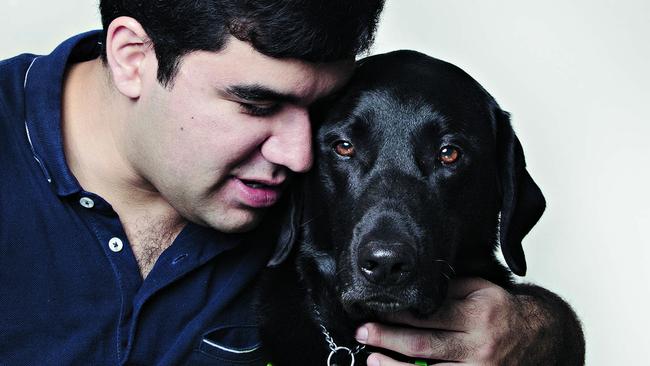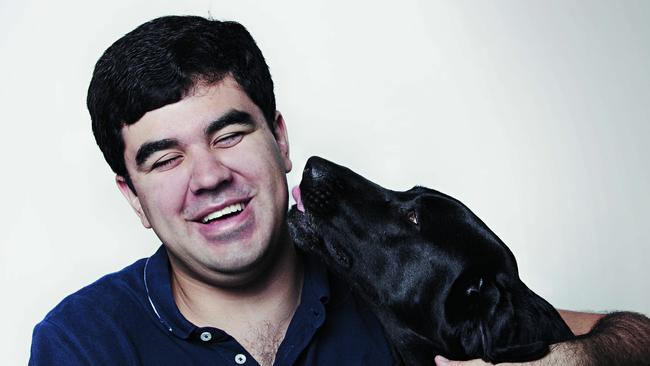Lock-step with Lockie
This black labrador spends every waking moment by his owner’s side. He’s not just a faithful companion, but Santiago Velasquez’s eyes on the world.

Their day begins soon after 6am with a series of movements so familiar they’re like clockwork. After rising from their beds, positioned side-by-side, Santiago Velasquez and his companion greet each other with affection and a leash is clipped to a collar. It’s a couple of dozen steps from their bedroom to the front door of the apartment, then down three floors in the lift to a small garden so that one of them can water the grass. “Quick quicks, Lockie,” says the young man, using the voice command for toileting. “Quick quicks.”
After breakfast, Velasquez — known to all as “Santi” — leads Lockie to the balcony where he brushes the dog in the morning light, black wisps of fur falling to the floor. The guide dog stands docile, wagging his tail and panting happily. “It’s a good bonding exercise,” says Santi, a handsome 21-year-old with a swimmer’s strong build, a crown of black hair and sporty-looking glasses. In the distance is an extraordinary view of the Brisbane city skyline and surrounding hills but Santi cannot see it. Since birth, he has been blind in one eye with only three per cent vision in the other.
It is a Wednesday in mid-October and they have a big day ahead. In an unpredictable, fast-paced world, Santi and Lockie rely on familiarity and routine as much as possible. Theirs is an intimacy of constant contact. “He’s very, very attached — that’s a massive understatement — because we spend pretty much every moment of our lives together,” says Santi, who takes almost an hour to groom his black labrador and then painstakingly shave his own facial hair by feel with an electric razor. “He takes a long time for everything,” says Santi’s mother Maria, laughing and rolling her eyes in mock exasperation. In truth, she and her husband Cesar are nothing less than patient, having taught their blind son that his only problem is that he cannot see, and that his blindness is no excuse for not doing the same household chores as his sighted brother, 18-year-old Camilo.
Downstairs at 9am, Santi reattaches the leash and repeats his voice command, while Lockie walks in circles and sniffs the lawn. “Quick quicks, buddy,” he says, and he means it: they have a bus to catch. Santi slips a fluorescent yellow harness over the dog’s head. With this action, Lockie has been trained to recognise that he is now in work mode, and his focus narrows to the singular task of guiding Santi from home to university — and, much later, back again. The dog is now six years old but has been in training since he was a puppy to fulfil this role. Santi never knew him as a puppy: Lockie was three when they first met on a rainy day at the Guide Dogs Queensland head office. Since January 9, 2015 — a date seared into Santi’s memory — they have scarcely spent an hour apart.
The bus comes to a stop and Lockie guides his master on board to a seat reserved for people with disability. Santi knows the 184 bus route by feel, due to the familiar turns and hills that deliver them 5km to their destination. From there, the pair follow a path that skirts the edge of South Bank and leads to the Goodwill Bridge. Slow walkers, cyclists, dawdlers, teenagers who stop suddenly in the middle of the walkway to take a selfie: Lockie guides his master around each of these human obstacles with ease. Once the flow of foot traffic becomes more predictable on the bridge, Lockie gently leads Santi into the clear. Sensing the opportunity, Santi opens his stride into a power-walk that would leave most sighted travellers in their dust, while Lockie trots beside him.
Halfway across the bridge, Santi’s right shoelace becomes loose. The three per cent vision in his right eye means that he can vaguely make out shapes, shadows and colours, so at the end of the bridge he finds a grassed area in the shade of a tree. “I’ve got to tie my shoe,” he says. How did he know it was undone? “The feeling and the noise, but I wasn’t going to stop on the bridge,” he says, removing the harness and retrieving a collapsible bowl from his backpack to give Lockie a drink. Momentarily off-duty, the dog becomes intensely interested in sniffing a passing Pomeranian, but does not desert his master.
Santi is studying a Bachelor of Electrical Engineering part-time at the Queensland University of Technology. He is part-way through his second year of study and today he is attending a 10am maths lecture. After settling into a chair in the front row he opens his laptop, inserts an earphone into his left ear and uses screen reading software to listen to a written description of the lesson that his lecturer, Elizabeth, has prepared for him.
Since he was small, Santi has been fascinated with mechanics and he loves learning how things work. While his blindness is a clear disadvantage he is determined to find the answers, even if it takes him a little longer. His sharp mind is always working on solving the problems he encounters. When the available tools are inadequate, his foresight extends to technology that does not yet exist. With some university friends, for instance, he is developing a business idea called Eyesyght. By placing a screen protector over a smartphone and using a companion phone app, users would be able to feel electrical impulses that convey visual information such as maps and diagrams.
Lockie knows his place in the classroom: on the carpet beneath Santi’s feet, brown eyes closed. After the lecture, when Santi visits QUT’s indoor pool to swim a few midday laps, he leaves Lockie in an office and accepts the help of staff to get into the pool. It is the first and only time all day that they are apart, and when Santi later knocks on the office door before opening it, Lockie explodes in greeting. Met with barks, licks and leaps, Santi says casually, “What’s up, dude?”

On a lawn in the centre of campus, QUT’s business school is hosting an event at which Santi is scheduled to give a short pitch to fellow entrepreneurs and potential investors. Without fuss, he steps onto the raised stage and grips a microphone with his right hand while holding Lockie’s leash in the other. A crowd of dozens mills in the shade, chomping on sausages and bread. “Good afternoon, everybody,” he begins, while Lockie stands panting beside him. “My name is Santiago, and I am the co-founder of Eyesyght. Now, this presentation is a great example of what we’re doing, because for this, there aren’t any visual aids. In our world, anything that has to do with sight is what gives you the most amount of information. As you can see, there is a dog running around me,” he says, gently tugging at the leash. “He’s actually my guide dog.”
It’s common practice, he says, for people to use Google Maps on their smartphone to get from point to point; the sighted population can interpret that data in just a few seconds. “But if you can’t see the map, how would you get that information?” Santi asks. “It turns out that there are 285 million people around the world who can’t see any graphical information whatsoever. So they still rely on printing things [in braille] and, well, honestly, who wants to carry an atlas? With Eyesyght, we’re developing technology to help vision-impaired people feel graphical information in real-time. So if I pull out my phone and pull up any image, any map, I would be able to trace said map, and said image, by just touching the screen, and feeling the contours and lines of said graphic.”
The applications for this idea, he explains, extend beyond supporting the low-vision community and into virtual reality, adding what’s known as haptic feedback — which relates to the perception and manipulation of objects using the sense of touch — to the experience of, say, holding a steering wheel or a gun in a virtual reality game. “With this technology, you would be able to do that,” he says, as Lockie stretches out his front paws on the stage, panting. “At the moment, we are in the development stage. This [business] area doesn’t exist. Somebody has to start, and well, I guess if I’m going to go forward, it’s better if I can’t see. Ladies and gentlemen, thank you very much.” He returns the microphone to the host, then raises Lockie’s harness in his left hand. They step down from the stage to the lawn at the same time, Santi smiling at the sound of applause.
In the afternoon, as Santi listens to a series of young entrepreneurs deliver polished presentations on the tenth floor of a sleek university building, Lockie dozes with his head draped protectively across Santi’s left boot, jaw resting on a firmly tied shoelace. Lockie has been trained to understand that home is wherever Santi happens to be. One thousand times a day or more, their bodies touch. Theirs is a mutually beneficial pairing that extends far beyond the companionship of an ordinary domestic pet. In Lockie, Santi has a faithful, dependable guide who navigates the contours and gradients of an urban landscape that would otherwise present considerable challenges. And in Santi, Lockie has an owner whose deep care and respect can be felt in each kind word and affectionate touch. The dog is an extension of the man.
Downstairs, just after 5pm, Lockie is fed and watered. The bowl of hard biscuits is his second substantial meal since breakfast, along with a kangaroo jerky treat from earlier. “It’s amazing, the level of commitment he displays,” says Santi with great admiration, looking down in the direction of his companion’s contented munching. “You won’t find a better worker, full stop.”
Santi had used a long cane for mobility until hedecided to apply for a guide dog. He noticed how it had helped a fellow student at Cavendish Road State High School, which had a unit dedicated to helping children with low vision. “And obviously, as a pet, you get to love them,” he says, “and you get to have their company.”
Guide Dogs Queensland mobility instructor Jodie Caldwell recalls that it took about 18 months to find a match for Santi. Training guide dogs is a demanding process that involves repetitive lessons and constant reinforcement. From the age of eight weeks to 18 months — from puppyhood to adolescence — the dogs live with volunteers who help raise and socialise them while they attend regular training sessions at Guide Dogs Queensland HQ. Just half of all trainees end up being assessed as suitable guide dogs. Once a dog is matched with a potential owner, Caldwell and her colleagues spend about 80 hours in the first few weeks of a pairing — five or six hours per day, most days per week — observing and supporting the new partnership, to give it the best chance of success.

For Caldwell, that meant accompanying Santi and Lockie to their first day of Year 12, as well as the weeks that followed. “I was keeping my distance. I was just there if things went pear-shaped.” Caldwell was curious about how this would play out, too: “We don’t have many dogs going into schools. It was something new for me; I’d never trained a school student with a dog.”
Nationally, there are more than 1000 working guide dog teams such as Santi and Lockie, with between 100 and 200 new teams trained each year depending on demand, which is steadily rising across the country. “There’s no such thing as a perfect match; there’s always compromise,” she notes. “But Santiago is what we call a dynamic, universal traveller. A lot of people we work with have the same travel routes day in, day out. Santiago has the ability to fly to Sydney tomorrow. Sure, he doesn’t know Sydney, but he’d have the ability and the confidence to be able to ask for assistance if needed. It’s a partnership between the two, and the handler is the senior partner. The dog actually never finishes training, so to speak, and Santiago is now Lockie’s guide dog trainer.”
After his meal break, Lockie leads Santi to a nearby building where a business school networking event is taking place. Santi and his undergraduate co-founders have entered Eyesyght into the QUT Bluebox Challenge for innovation, and he received an email yesterday asking him to attend. At the fringe of a lively crowd, Santi and Lockie stand facing the hubbub. Soon, they are approached by two women. “Can we pat your dog, Santiago?” asks one. “You can say hello for the moment, yes,” he nods. “He’s working right now.” Generally, when a working dog is wearing a harness they’re not to be distracted but few can resist the charms of a labrador and Santi understands this. He’s usually happy to allow a quick pat.
The younger woman, Lauren, asks about Lockie’s role in Santi’s life. “Basically, he’s my guide,” he replies. “I tell him where to go. He just makes sure we don’t crash into people; we follow paths, and he tells me where stairs are.” Confused, Lauren asks whether that means Lockie knows the location of certain landmarks. “No, he has no idea,” says Santi, while the dog dolefully eyes off passing plates of dumplings. “The best description is: I’m the GPS — I kind of know where I’m going — and he’s the driver. He needs to know: ‘OK, there’s a car in front of us; I’m going to apply the brakes. There’s a traffic light; we’re going to stop.’ That’s what he does, but he has no idea of where we’re going. They do get to learn your routine. They’re smart enough to realise, ‘OK, I know where we are’. But I can’t say, ‘OK, let’s go to QUT’. That doesn’t work.”
As part of the Bluebox Challenge, $500,000 in cash prizes and services are awarded. During the ceremony, Santi is announced as one of the winners of a $25,000 cash prize for Eyesyght. It takes a bit of stage management to part the crowd and direct man and dog up the stairs for a photo opportunity. After they leave the stage, his name is announced a second time. “Santi, to avoid you walking up again, we’ll bring you out the front,” says the MC. “You’re a very, very nice person!” replies Santi, and the crowd laughs and applauds.
Eyesyght wins a second prize of $10,000 in services from an intellectual property law firm. As Lockie guides Santi back through the crowd, voices of congratulations emerge from the darkness of his near-total blindness. “Well done, Santi!” whispers Lauren. “That is awesome! Hopefully we’ll see your apps everywhere!” He grins and replies, “Thank you. We’ll get it there eventually.” He pauses, then says to himself, or perhaps to Lockie: “Oh, crap, I’m excited!”
He’s won $35,000 in prizes and has been feted before an audience of bright people but the day is not yet over. Lockie still has to guide Santi through the noisy streets of central Brisbane to the bus station. The dog has been working almost 14 hours on the trot, in unpredictable and busy environments, making decisions, acting as driver to Santi’s GPS. In all that time, he hasn’t faltered. On the bus home, Lockie lies underneath his master, head on the floor, until Santi senses it’s time to alight.
Before riding the lift three floors up to share his happy news with his family, Santi takes a left turn into the enclosed garden near the building entrance. When he removes Lockie’s harness at 8pm, the dog is officially off-duty — but for one last command. “Quick quicks, buddy,” calls Santi, encouraging Lockie to water the grass once more. “Quick quicks.” Tonight, they will sleep in their beds positioned side-by-side. Tomorrow, they will arise and do it all again.

